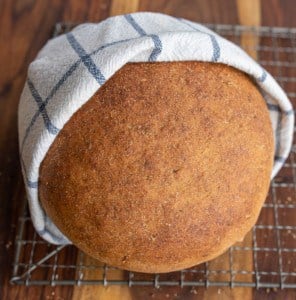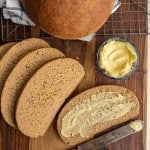Rye Bread
A classic rye bread recipe with caraway seeds. The recipe makes two round loaves that are tender and sturdy, and this bread makes the best toast and sandwiches!
Servings: 2 Loaves
Ingredients
- 3 tablespoons active dry yeast
- ¾ cup warm water
- 2 cups warm milk
- ¼ cup molasses
- 3 tablespoons melted butter
- 1 tablespoon salt
- 2 tablespoons caraway seed
- 4 cups all-purpose flour
- 3-4 cups dark rye flour
Instructions
- In a large mixing bowl dissolve the yeast in warm water and the allow the mixture to sit for 3-5 minutes.
- Add the milk, molasses, butter, salt, caraway seeds and the all purpose flour.
- Mix very well until smooth and continue to mix for another 2-3 minutes at this stage (this helps to develop the gluten).
- Add enough rye flour to make dough easy to handle and stir to incorporate as well as you can.
- Remove the dough from the bowl and place it on a floured work surface.
- Knead dough until smooth (about 10 minutes), gradually adding any remaining rye flour.
- Place the smooth dough in a greased bowl (I just grease the one I mixed it up in).
- Turn the dough around until greased side is up. Cover and let rise for 1 hour.
- Punch down dough and remove it from the bowl onto a lightly floured surface.
- Divide into two even pieces. Form each piece of dough into round loaves.
- Place the shaped loaves on a parchment lined baking sheet and let rise until double (about 1 hour)
- Bake at 425°F for 25-30 minutes or until the top is a deep brown.
- Remove from the oven and allow to cool at least 30 minutes before slicing.

Notes
Popular Substitutions and Variations:
- Sourdough Starter: Instead of using commercial yeast, some bakers prefer to make rye bread with a sourdough starter. This natural fermentation method gives the bread a distinct tangy flavor and can be a great option for those who enjoy sourdough bread.
- Honey or Maple Syrup: If you don't have molasses or prefer a different sweetener, you can substitute honey or maple syrup for a unique flavor twist.
- Olive Oil or Vegetable Oil: While melted butter is traditional, you can use olive oil or vegetable oil for a different taste and texture. Olive oil can add a fruity note to the bread.
- Seeds and Nuts: In addition to caraway seeds, you can experiment with other seeds like fennel, anise, or sesame seeds. Adding chopped nuts, such as walnuts or sunflower seeds, can also provide extra texture and flavor.
- Rye Flour Options: You can use light rye flour if that's what you have on hand. I like the dark rye as it lends to a little more flavor in my opinion. It's the whole grain version of light rye (like a whole wheat flour vs. all-purpose) and it adds a lot to the texture of the bread too.
- Be sure to store the bread in a paper bag or bread box rather than a plastic bag to keep it from getting soggy.
- Rye bread freezes beautifully! Slice it before freezing so it is easy to pop in the toaster when you are ready to eat it.
Nutrition
Serving: 1 of 18 slices | Calories: 1903kcal | Carbohydrates: 355g | Protein: 54g | Fat: 31g | Saturated Fat: 16g | Polyunsaturated Fat: 3g | Monounsaturated Fat: 7g | Trans Fat: 1g | Cholesterol: 74mg | Sodium: 3744mg | Potassium: 1965mg | Fiber: 29g | Sugar: 46g | Vitamin A: 942IU | Vitamin C: 1mg | Calcium: 511mg | Iron: 19mg
QR code
Scan this QR code with your phone's camera to view this recipe on your mobile device.
